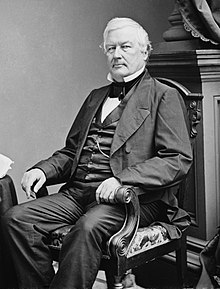Presidency of Millard Fillmore
| Millard Fillmore | |
|---|---|
 |
|
| 13th President of the United States | |
|
In office July 9, 1850 – March 4, 1853 |
|
| Vice President | None |
| Preceded by | Zachary Taylor |
| Succeeded by | Franklin Pierce |
| 12th Vice President of the United States | |
|
In office March 4, 1849 – July 9, 1850 |
|
| President | Zachary Taylor |
| Preceded by | George M. Dallas |
| Succeeded by | William R. King |
| Member of the U.S. House of Representatives from New York's 32nd district |
|
|
In office March 4, 1837 – March 3, 1843 |
|
| Preceded by | Thomas C. Love |
| Succeeded by | William A. Moseley |
|
In office March 4, 1833 – March 3, 1835 |
|
| Preceded by | Seat established |
| Succeeded by | Thomas C. Love |
| Chairman of the House Ways and Means Committee | |
|
In office March 4, 1841 – March 3, 1843 |
|
| Preceded by | John Winston Jones |
| Succeeded by | James I. McKay |
| 14th Comptroller of New York | |
|
In office January 1, 1848 – February 20, 1849 |
|
| Governor |
John Young Hamilton Fish |
| Preceded by | Azariah Cutting Flagg |
| Succeeded by | Washington Hunt |
| Personal details | |
| Born |
January 7, 1800 Moravia, New York, U.S. |
| Died | March 8, 1874 (aged 74) Buffalo, New York, U.S. |
| Resting place |
Forest Lawn Cemetery Buffalo, New York |
| Political party |
|
| Spouse(s) |
|
| Children | Millard and Mary |
| Profession | Lawyer |
| Signature | |
| Military service | |
| Allegiance |
|
| Years of service | 1820s–1830s (militia) 1860s–1870s (guard) |
| Rank |
Major (militia) Captain (guard) |
| Unit |
New York Militia New York Guard |
| Commands | Union Continentals (New York Guard) |
| Battles/wars | American Civil War |
| The Fillmore Cabinet | ||
|---|---|---|
| Office | Name | Term |
| President | Millard Fillmore | 1850–1853 |
| Vice President | None | 1850–1853 |
| Secretary of State | Daniel Webster | 1850–1852 |
| Edward Everett | 1852–1853 | |
| Secretary of Treasury | Thomas Corwin | 1850–1853 |
| Secretary of War | Charles Magill Conrad | 1850–1853 |
| Attorney General | Reverdy Johnson | 1850 |
| John J. Crittenden | 1850–1853 | |
| Postmaster General | Nathan K. Hall | 1850–1852 |
| Samuel Dickinson Hubbard | 1852–1853 | |
| Secretary of the Navy | William Alexander Graham | 1850–1852 |
| John P. Kennedy | 1852–1853 | |
| Secretary of the Interior | Thomas McKean Thompson McKennan | 1850 |
| Alexander Hugh Holmes Stuart | 1850–1853 | |
Millard Fillmore (January 7, 1800 – March 8, 1874) was the 13th President of the United States (1850–53), the last to be a member of the Whig Party while in the White House. A former congressman from New York, Fillmore was elected the nation's 12th Vice President in 1848, and was elevated to the presidency by the death of Zachary Taylor. He was instrumental in getting the Compromise of 1850 passed, a bargain that led to a brief truce in the battle over slavery. He failed to win the Whig nomination for president in 1852; he gained the endorsement of the nativist Know Nothing Party four years later, and finished third in that election.
Fillmore was born into poverty in the Finger Lakes area of New York state; his parents were tenant farmers during his formative years. He rose from poverty through study, and became a lawyer though he had little formal schooling. He became prominent in the Buffalo area as an attorney and politician, elected to the New York Assembly in 1828, and the U.S. House of Representatives in 1832. Initially, he belonged to the Anti-Masonic Party, but became a Whig as the party formed in the mid-1830s; he was a rival for state party leadership with editor Thurlow Weed and Weed's protégé, William H. Seward. Through his career, Fillmore decried slavery as an evil, but one beyond the powers of the federal government, whereas Seward was not only openly hostile to slavery, he argued that the federal government had a role to play in ending it. Fillmore was an unsuccessful candidate for Speaker of the House when the Whigs took control of the chamber in 1841, but was made Ways and Means Committee chairman. Defeated in bids for the Whig nomination for vice president in 1844, and for New York governor the same year, Fillmore was elected Comptroller of New York in 1847, the first to hold that post by direct election.
...
Wikipedia
